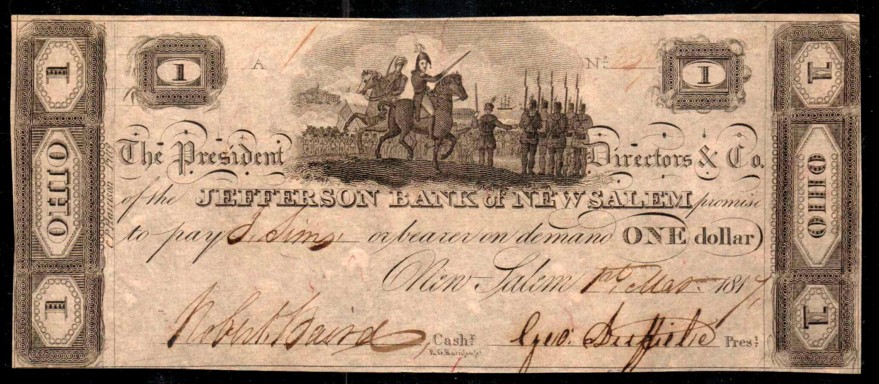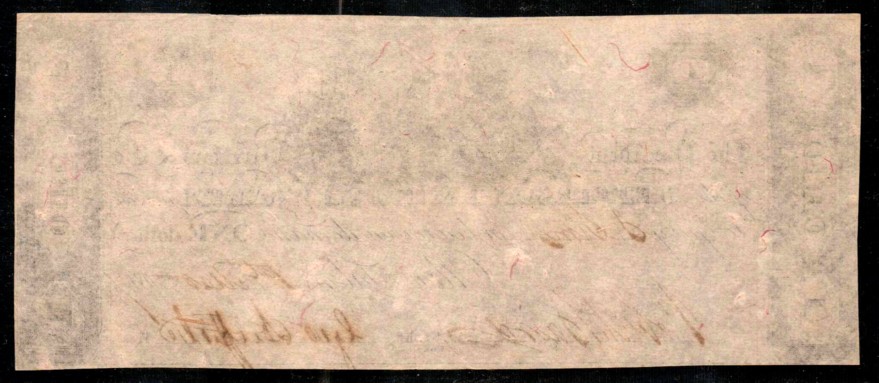Ohio 1817 $1
Jefferson Bank of New Salem
The following banknote with the almost ‘cartoony’ looking vignette is dated 1817, and shows then-General Andrew Jackson as rousing the spirits of the troops during the War of 1812 at the battle of New Orleans, which actually took place on January 8, 1815. The troops would have most likely been 5,000 militiamen in real life, who were led by Jackson against 7,500 British. While many thought at the onset that the British would win the battle, Jackson, a tough yet fair leader who was not afraid to fight along with his men, rallied his troops and lived up to his to his reputation for being as ‘tough as Old Hickory Wood’ on the battlefield. They soundly defeated the British forces and his actions there cemented his reputation and fame. The nickname “Old Hickory” stuck with him, and with his reputation as a war hero and a fair leader helped him later on to win the presidential election, serving from 1829-1837. Andrew Jackson had his depiction on banknotes a full 12 years before becoming president!
Settled in 1802 by emigrants from the Virginia and Maryland areas, New Salem was platted by Isaac Helmick on November 9, 1802. It is located between New Philadelphia and Steubenville. Its name changed to Annapolis when the Post Office was installed, and today still bears the Annapolis name. There is a new New Salem, which is a small village, and along with Pleasantville, is in the middle of the Lancaster Thornville road. Back in 1817, old New Salem, now Annapolis, was large enough to have not only two banks, the Farmers Bank and the Jefferson Bank, but also a juicy story to go along with it.
Due to the Industrial Revolution, the years of 1815-1819 were a financial boom throughout most of the United States. As many people were making more money through work and investments, private banks also boomed. According to the Federal Deposit Insurance Corporation (FDIC), by 1819 there were 420 private banks in the United States, each one of which was printing its own banknotes and issuing them to the public. The Second Bank of the United States was established in 1816 in the aftermath of the War of 1812. A major function of the Second Bank of the United States was to regulate public credit issued by private banks. The ‘Panic of 1819’ occurred when the Second Bank of the United States called its loans, which caused many private banks to fail. When the panic was over there were about 300 private banks in the U.S., the rest of them closed, including this Jefferson Bank of New Salem, having been in business for only two years.
The Jefferson Bank began in the second half of 1816 and had Dr. George W. Duffield serving as the bank president and Mr. Robert Baird serving as its cashier. The 1817 issue of banknotes by the Jefferson Bank included seven denominations including three issues in dollar denominations: the 1-dollar a 3-dollar and a 5-dollar, and four fractional pieces: 6¼ cents, 12½ Cents, 25 Cents, and 50 Cents. The cent issues were evidently without vignettes. J. Wilson engraved the fractional denominations, and R. G. Harrison, Jr. engraved the Dollar Denominations.
Of this one-dollar denomination, there are evidently variations in the central vignette design of the horse that Jackson is riding, as well as variations in the design of the embossing around the large numeral 1.
When the Jefferson Bank collapsed, the bank president, Dr. George W. Duffield, had several legal claims brought against him in efforts to recover losses stemming from the notes that were in circulation. One such suit being heard by the Justice of the Peace Jacob Vance, there was an argument that ensued between Dr. Duffield and the prosecuting attorney, David Redick. When the court adjourned, Duffield and Redick left the courthouse whereupon Mr. Redick pounced on Dr. Duffield. They wrestled on the ground only for a short while, but only Dr. Duffield got up. He had stabbed Mr. Redick in the neck with a medical scalpel and he lay on the ground bleeding, and later died on the way to the hospital.
Dr. Duffield went to trial for murder in August 1818, where he pleaded that he had felt that his life was in danger during the attack, and so he used his scalpel to defend himself. Dr. Duffield was acquitted as he had been the one who was attacked. Business resumed, and the cashier, Mr. Robert Baird, issued personal promissory notes in $1,000 denominations to cover the banks losses.
Dr. George W. Duffield died on April 19, 1879 and is buried in the Germano Cemetery in Harrison County, Ohio, near Steubenville, Ohio. His headstone shows he lived for 87 years, 3 months and 24 days. His wife and two children survived him.
Robert Baird died in Annapolis, Ohio on 07 Aug 1838 aged 49, leaving a wife and 10 children.
Andrew Jackson was not a fan of paper money due to the facts that there could be more money printed than was backed by funds, which led to many banks closing and leaving their customers with nothing but worthless scraps of paper. In fact, Andrew Jackson suffered a loss himself after accepting banknotes from a private bank that had gone bankrupt, causing him to be wary of bank issued paper money ever since.
Andrew Jackson was also suspicious of the 2nd Bank of the United States, which was printing national currency, and was operating without any better safeguards than corporate banks. The Bank was originally supposed to maintain its specie ratio at 20 percent. What was happening instead was the bank held a wildly fluctuating ratio that floated from 12 percent to 65 percent. In addition, they were seen as being too powerful, operating as the nation’s bank, but with no governmental oversight, it was feared by many that the 2nd Bank of the United States could limit loans and currency supplies and could possibly create an oligarchy, or a government run by the bank.
In 1833, Andrew Jackson stopped all federal deposits to the 2nd Bank of the United States, drastically reducing their influence on the nations credit. Then, in 1834, the 2nd Bank lost the vote to become re-chartered and it subsequently folded. This decision was made without enough planning and helped the nation suffer a depression now called the Panic of 1837, which saw massive foreclosures, business closures, bankruptcies, and a steep rise in unemployment for almost seven years.
An interesting side-note is that the 2nd Bank of the United States was created in 1816, but opened in 1817, the same year as this banknote featuring Andrew Jackson was issued.

